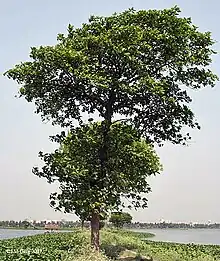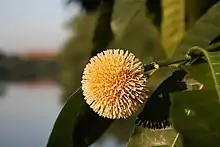Neolamarckia
Neolamarckia is a genus with one or two species of trees native to the Old World tropics.[2][1] It has often been confused with other genera, particularly Nauclea and Neonauclea to such an extent that descriptions of Neolamarckia may state incorrectly that its fruit is a capsule.[1]
| Neolamarckia | |
|---|---|
 | |
| Neolamarckia cadamba | |
 | |
| Neolamarckia cadamba | |
| Scientific classification | |
| Kingdom: | Plantae |
| Clade: | Tracheophytes |
| Clade: | Angiosperms |
| Clade: | Eudicots |
| Clade: | Asterids |
| Order: | Gentianales |
| Family: | Rubiaceae |
| Subfamily: | Cinchonoideae |
| Tribe: | Naucleeae |
| Genus: | Neolamarckia |
| Synonyms[1] | |
|
Anthocephalus auct. non A. Rich. | |
Description
The inflorescenes are spherical, containing many small flowers. The fruit is a drupe that sometimes separates into four sections.[1]
Species
- Neolamarckia cadamba, native to east Asia, south Asia, and southeast Asia
- Neolamarckia macrophylla, native to south Asia, and southeast Asia
Botanical nomenclature
The genus name was created to replace Anthocephalus, which had been based on two unrelated herbarium specimens, one of which was mislabelled. Consequently, the true Anthocephalus is a synonym of the genus Breonia, and a new name was needed for the trees that had been generally known by the incorrect name.[3]
References
- "!Neolamarckia Bosser", Flora Mesoamericana (in Spanish), retrieved 7 April 2016
- Tao Chen and Charlotte M. Taylor, "Neolamarckia Bosser, Bull. Mus. Natl. Hist. Nat., B, Adansonia. 6: 247. 1985", Flora of China online, vol. 19
- J. Bosser (1984), "Sur le type du Cephalanthus chinensis Lam. Neolamarckia, nouveau nom pour Anthocephalus auct. non A. Rich. (Rubiaceae)", Bulletin du Muséum National d'Histoire Naturelle, Section B, 6: 243–248